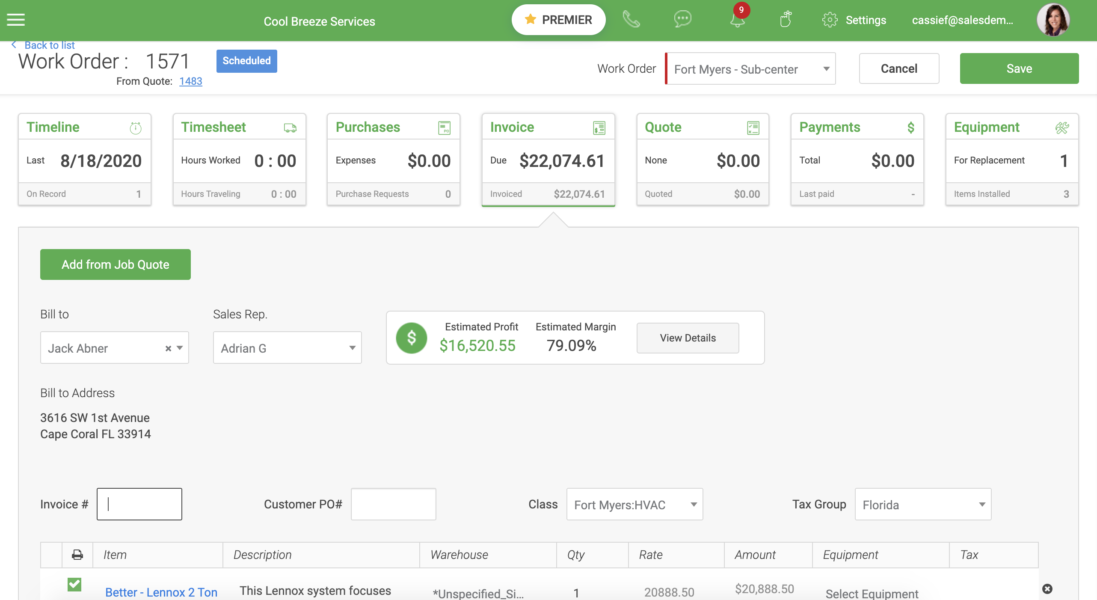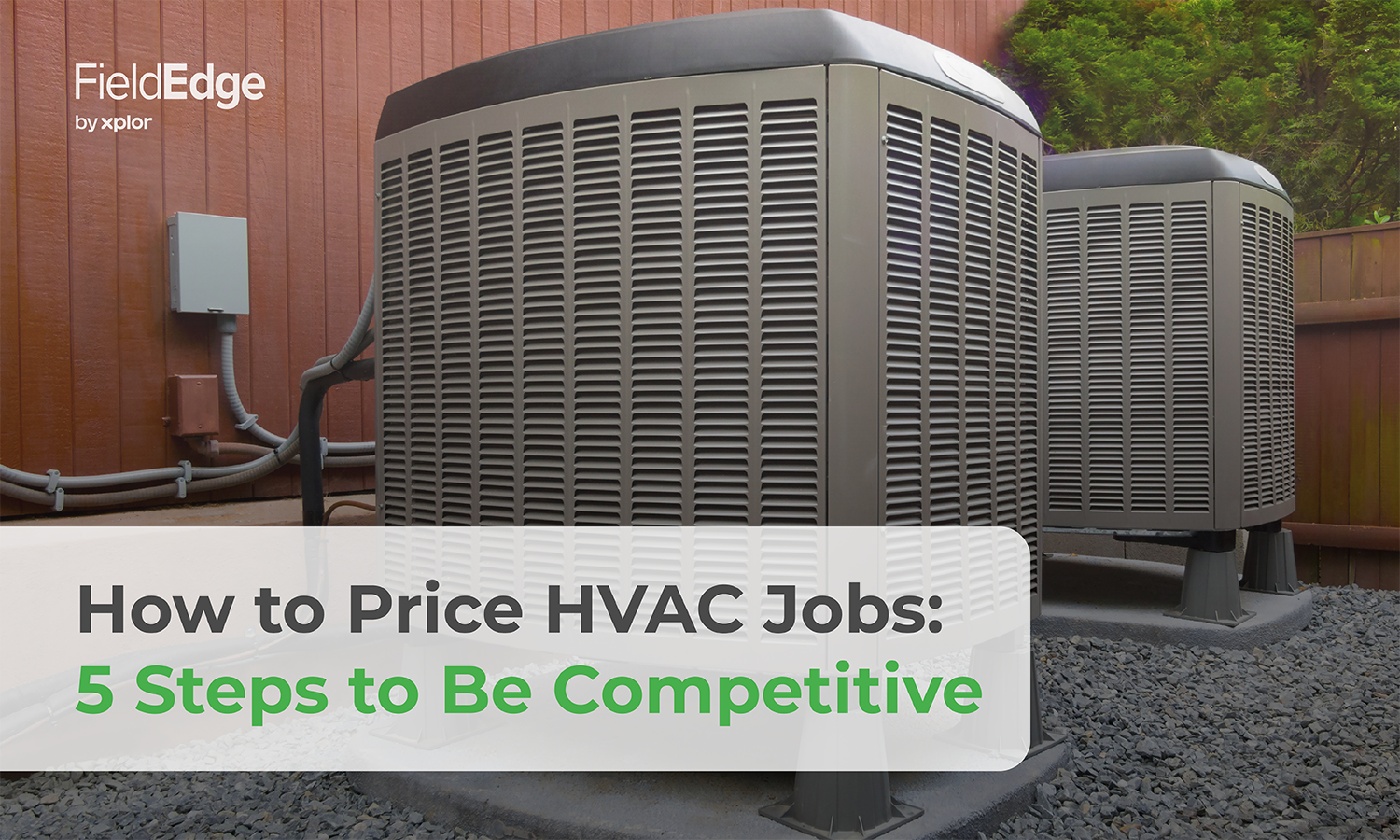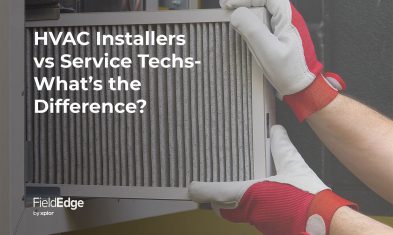Knowing how to price HVAC jobs for your business is a critical factor in achieving long-term success. While it can seem intimidating, this quick guide will give you everything you need to significantly boost profitability, customer satisfaction and market position against the competition.
Understanding how to price HVAC jobs to beat the competition helps you attract more customers, retain existing ones and ensure sustainable growth.
In this easy guide, we will cover:
- Understand competitive pricing
- Factors influencing how to price HVAC jobs
- Select an HVAC pricing method
- Meet with a trusted CPA
- Utilize the right tools and technologies to assist with pricing
Knowing how to price HVAC jobs competitively involves setting prices based on market conditions, competitor prices and the value your services provide to customers.
This quick and easy guide will explore the essentials of competitive pricing, including the factors that influence how to price HVAC jobs, effective strategies, the importance of value-based pricing and the tools available to help you set/maintain competitive prices.
1. Understand Competitive Pricing
Competitive pricing is the practice of researching what your competitors are charging. This strategy ensures that your prices are in line with the market, making your business attractive to potential customers who are comparing options. Though it’s a good starting point, you have to determine how your pricing stands up against the competition.
Analyzing competitor pricing helps you understand the pricing landscape. If your prices are significantly higher or lower than your competitors, customers may question the value or quality of your services.
Even though it’s important to do research on the competition’s prices, it’s also important not to copy their prices. After all, their overhead costs, goals and unique needs are different from your business. Remember, you’re only using competitor research as a general rule of thumb to see what you’re up against.
Why Competitive Pricing Matters
- Attracts Customers: Competitive pricing can help draw in customers who are price-sensitive and looking for the best deal.
- Builds Trust: Transparent and fair pricing can build trust with your customers, encouraging repeat business.
- Market Positioning: Competitive pricing helps position your business favorably within the market, especially if you offer additional value or superior service.
Average U.S. Prices for HVAC Services
Take a look at a few average price ranges for HVAC services in the U.S. in 2024:
| HVAC Service | Average Price Range |
| AC Installation | $2,500-$7,500 |
| AC Repair | $150-$650 |
| Furnace Installation | $2,000-$5,400 |
| Furnace Repair | $125-$480 |
| Tune Up | $70-$200 |
| AC Compressor | $1,300-$2,500 |
| Blower Motor Repair | $150-$700 |
2. Factors Influencing How to Price HVAC Jobs
Several factors influence how you should set your service prices. Understanding these factors can help you develop a more effective pricing strategy.
Cost of Goods Sold (COGS)
The cost of goods sold includes the direct costs associated with delivering your HVAC services, such as labor, parts and materials. Your pricing must cover these costs to ensure profitability.
Market Demand
Market demand can fluctuate based on seasonality, economic conditions and consumer trends. Higher demand may allow for higher pricing, while lower demand might necessitate discounts or promotions.
Value Proposition
The unique value your business provides can justify your pricing. This includes factors such as service quality, customer service, warranties and any additional benefits you offer.
Geographic Location
Your location can impact pricing due to varying costs of living, local competition and regional market conditions.
3. Select an HVAC Pricing Method
Knowing how to price HVAC jobs involves considering various pricing methods to find the best fit for your business. Here are several strategies that your business can choose from:
Flat Rate Pricing
With flat rate pricing, customers know upfront what they will be paying for a specific service, regardless of how long it takes the technician to complete the job. This eliminates any surprises or uncertainties, providing peace of mind to clients.
For HVAC businesses, flat rate pricing promotes fairness and helps build trust with customers, as they are charged based on the service provided rather than the time taken. Implementing flat rate pricing can lead to better customer relationships, increased business efficiency, and ultimately, higher profitability.
However, if you’re a new HVAC business, flat rate pricing might not be right for you. It’s important to know your average job times if you’re using flat rate pricing. This way, you won’t lose profits if you underestimate how long certain jobs take.
Time And Materials Pricing
Time and materials pricing is another common method used in the HVAC industry for billing customers for services provided. Unlike flat rate pricing, time and materials pricing charges customers based on the actual time spent on the job and the materials used. This pricing method can be beneficial for HVAC companies when the scope of work is unclear or when unexpected issues arise during the service call.
While this method provides more flexibility and accuracy in billing, it can sometimes lead to uncertainty for customers regarding the final cost of the service. However, time and materials pricing can be advantageous for HVAC companies when dealing with complex or unique jobs where it is challenging to predict the total cost upfront
HVAC businesses using time and materials pricing need to ensure transparent communication with customers throughout the service process to maintain trust and satisfaction. Plus, this pricing method is especially useful for new businesses that might not average job times. This way, new HVAC businesses can still maintain profitability, despite a job taking longer than expected.
By the way, did you know, you can easily track your average job times and materials while on-the-go using FieldEdge? Here’s how it looks:
Cost-Plus Pricing
Cost-plus pricing involves adding a markup to your COGS to ensure a profit margin. This straightforward method ensures that all costs are covered while generating profit.
Market-Based Pricing
Market-based pricing sets your prices based on what the market is willing to pay. This strategy requires thorough market research to understand the current pricing trends and customer expectations.
Penetration Pricing
Penetration pricing involves setting lower prices to attract customers and gain market share quickly. This can be effective for new businesses looking to establish themselves, but it must be used cautiously to avoid long-term losses.
Premium Pricing
Premium pricing positions your services as high-end, with higher prices reflecting superior quality and service. This approach can attract customers who perceive high price as an indicator of high value.
Dynamic Pricing
Dynamic pricing adjusts prices based on real-time market demand and supply conditions. This flexible approach can help maximize revenue during peak times and attract customers during slower periods.
BONUS: Which Pricing Method Is Right for Your HVAC Business?
Most HVAC businesses choose between flat rate and time/materials pricing. While there’s no “one size fits all” approach, the unique needs of your business will determine which method is right for your business.
4. Meet With a Trusted CPA
Meeting with a trusted CPA is crucial for HVAC businesses to ensure financial health and compliance. A CPA specializes in accounting, taxation, and financial management, offering essential expertise that can benefit HVAC businesses in various ways.
A trusted CPA can help HVAC businesses optimize their financial strategies. By analyzing financial data and trends, a CPA can provide valuable insights on cost-saving opportunities, budgeting, and forecasting. They can help identify areas where expenses can be reduced or reallocated to improve profitability.
Also, from a tax perspective, a CPA can assist HVAC businesses in navigating complex tax laws and regulations. By staying up-to-date with tax laws, a CPA can
- Help minimize tax liabilities
- Maximize deductions and
- Ensure compliance with all tax requirements
This proactive approach can help HVAC businesses avoid costly tax mistakes and penalties, allowing them to focus on their core operations without the stress of tax-related issues.
A trusted CPA can also provide strategic financial planning guidance for HVAC businesses. They can help with long-term financial planning, investment decisions and business expansion strategies. By working closely with a CPA, HVAC businesses can make informed financial decisions that align with their business goals and objectives, ensuring sustainability and growth in the competitive HVAC industry.
In addition, a CPA can also offer valuable advice on financial risk management and internal controls. By assessing financial risks and implementing internal control measures, a CPA can help safeguard the assets and interests of the HVAC business.
The best CPAs can help you to:
- Calculate costs
- Take local taxes into consideration
- Set the right profit goals and ideal markup for your business
Remember, the upfront cost of the right CPA is well worth the assurance of long-term success and profitability in your HVAC business. DO NOT skip this crucial step! Always meet with a CPA before finalizing any financial decisions in your business.
5. Utilize the Right Tools and Technologies to Assist with Pricing
Several tools and technologies can help you with knowing how to price HVAC jobs and maintain competitive pricing.
Pricing Software
Pricing software can automate pricing analysis, track competitor prices and adjust your prices based on predefined rules and market conditions. This ensures your prices remain competitive without constant manual adjustments.
Customer Relationship Management (CRM) Systems
CRM systems help you understand your customers better by tracking their preferences, purchase history and feedback. This data can inform your pricing strategy by highlighting what your customers value most.
Financial Management Tools
Financial management tools can help you track your costs, revenues and profitability. Understanding your financial performance is crucial for setting prices that ensure profitability.
Plus, did you know, you can seamlessly sync your QuickBooks account to FieldEdge to eliminate double-data entry?

Explore how FieldEdge helps improve the pricing process. Book a demo for free on FieldEdge today!
How to Price HVAC Jobs the Right Way
Now, you know how to price HVAC jobs for maximum profit. By following the essential steps in this easy guide, you can develop a pricing model that attracts customers and ensures profitability in your business for many years to come.
Key takeaways:
- Competitive pricing is essential for attracting and retaining customers.
- Influencing factors include COGS, market demand, competitor pricing, value proposition and location.
- Pricing Strategies include cost-plus, market-based, penetration, premium and dynamic pricing.
- Tools and technologies that can help include pricing software, CRM systems and financial management tools.
By focusing on competitive pricing, your HVAC business can thrive in a competitive market, ensuring long-term success and growth.
Related: 5 Ways to Implement an HVAC Price Increase Without Losing Customers




